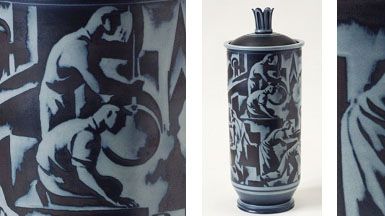
Press release -
New acquisition: Lidded urn designed by Gunnar Nylund
Nationalmuseum has added a large porcelain lidded urn to its ceramics collection. The urn was designed by Gunnar Nylund, one of the most prominent Scandinavian ceramicists of the 20th century. Although the urn is most definitely a luxury item, it is decorated with images of workers, factories and cityscapes, reflecting the contemporary cult of the machine.
In Sweden, Gunnar Nylund is best known for his stoneware animals produced by Rörstrands Porslinsfabrik, where Nylund served as artistic director. However, he had an international background, having been raised and educated in France, Finland and Denmark.
Before making his career in Sweden, Nylund worked at Bing & Gröndahl in Copenhagen in the 1920s. In partnership with Nathalie Krebs, he later started Saxbo, which became renowned for its stoneware, considered revolutionary at the time. In the 1930s Nylund worked mainly in Sweden, launching his Flambé series, which generally featured classical imagery in black and brown on a brown, green or light blue background.
During a short residency in 1937/38 at his former employer, Bing & Gröndahl, Nylund created the unusually large lidded urn (60 centimetres tall) that has now been donated to Nationalmuseum. Nylund used the same technique – Flambé – as at Rörstrand, but the motif differs considerably from the fairly conventional imagery he used in Sweden.
The urn is decorated with images of male manual labourers in powerful poses, in a style closely resembling the socialist realism that dominated the contemporary art scene in some of Europe’s totalitarian dictatorships. The contrast between imagery and material is striking: a decidedly luxury item decorated with heroic worker motifs.
The urn is a significant addition to Nationalmuseum’s 20th-century ceramics collection, representing decorative imagery of a type not previously represented. This important acquisition is a generous gift from the Friends of Nationalmuseum Bengt Julin Fund.
Further information
Anders Bengtsson, curator applied art and modern design, anders.bengtsson@nationalmuseum.se, +46 8 5195 4385
Hanna Tottmar, press officer, hanna.tottmar@nationalmuseum.se, +46 8 5195 4390
Press images
www.nationalmuseum.se/pressroom
Nationalmuseum is Sweden’s premier museum of art and design. The collections comprise older paintings, sculpture, drawings and graphic art, and applied art and design up to the present day. Nationalmuseum collaborates with Svenska Dagbladet, Fältman & Malmén and Grand Hôtel Stockholm. For more information visit www.nationalmuseum.se.
Categories

